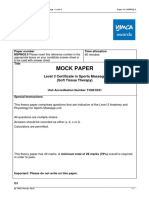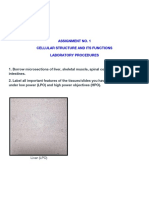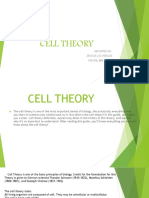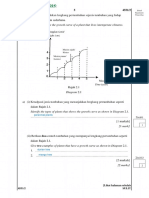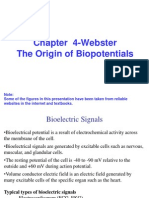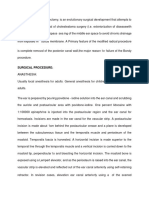Plant and Animal Immune System
Plant and Animal Immune System
Uploaded by
Kathleen GauranCopyright:
Available Formats
Plant and Animal Immune System
Plant and Animal Immune System
Uploaded by
Kathleen GauranOriginal Title
Copyright
Available Formats
Share this document
Did you find this document useful?
Is this content inappropriate?
Copyright:
Available Formats
Plant and Animal Immune System
Plant and Animal Immune System
Uploaded by
Kathleen GauranCopyright:
Available Formats
Plant and Animal Immune System
1. Describe the innate and adaptive immune responses as they would occur after someone coughs on
you.
Nonspecific defensive mechanisms that kick in immediately or within hours of an antigen's
presence in the body are referred to as innate immunity. Physical barriers, such as skin,
chemicals in the circulation, and immune system cells that target foreign cells in the body are
examples of these systems. When someone coughs on you, the cilia present in your nose and
respiratory tract traps dirt and bacteria and prevents it from invading your respiratory
system. Antigen-specific immune response is referred to as adaptive immunity. The adaptive
immune response is more sophisticated than the innate immune response. First, the antigen
must be processed and identified. The adaptive immune system develops an army of immune
cells specifically designed to target an antigen after it has been identified. Adaptive immunity
also includes a "memory" that improves the efficiency of future responses to a specific
antigen.
2. Why is protection resulting from a vaccination considered active immunity rather than passive
immunity?
Active immunity is immunity to a pathogen that develops after exposure to the infection.
When the body is exposed to a new disease agent, B cells produce antibodies that aid in the
destruction or neutralization of the pathogen. Following a vaccination, a person can develop
a resistance to a disease. Vaccines elicit an immune response by using a pathogen that has
been weakened or killed. This tricks the body into thinking there is a threat, even though the
pathogen is not capable of infecting the body in its state. When a person's immune system
recognizes this pathogen, the body then responds by eliminating it. This includes the
production of new antibodies and memory cells that are specific to the infection.
3. Compare the development of B cells and T cells
Within the bone marrow, stem cells differentiate into a variety of blood cells in a process
called hematopoiesis. Before developing into their separate lymphocyte types, all
lymphocytes begin from a common lymphoid progenitor. Differentiation of lymphocytes into
different types follows a variety of hierarchical and more plastic paths. Lymphopoiesis is the
process of lymphocyte production. B cells mature into B lymphocytes in the bone marrow,
whereas T cells travel to the thymus, where they mature. After maturation, lymphocytes enter
the bloodstream and peripheral lymphoid organs, such as the spleen and lymph nodes, where
they search for invading pathogens and/or tumor cells.
4. What does the graph mean? Provide a brief translation.
The graph shows the primary and secondary immune responses associated to antibody
formation after initial and subsequent antigen exposure. Specificity and memory are two
crucial properties of adaptive immunity. The adaptive immune system's ability to target
specific infections is referred to as specificity, while its ability to respond promptly to
pathogens to which it has previously been exposed is referred to as memory. As shown in the
graph, the immune system’s response upon second exposure occurred much faster and
results in a substantially larger antibody concentration as compared to the first exposure to
the antigen.
ESSAY
Situation: A plant biologist observed a peculiar pattern when a tropical shrub was attacked by caterpillars.
After a caterpillar ate a leaf, it would skip over nearby leaves and attack a leaf some distance
away. Simply removing a leaf did not trigger the same change nearby. The biologist suspected
that a damaged leaf sent out a chemical that signaled other leaves. How could this hypothesis
be tested?
Consider the following issues and questions: Is the substance safe for humans to consume?
What impact does it have on the environment?
Could it produce dangerous contaminants or wastes as a result of its production? What types
of testing are required to prove its safety? What is the cost of making and using it? Do the
advantages outweigh the expenses and risks? Is it worth it to use an artificial chemical on
food just to make it look better? A scientist could investigate the chemical's stability in a
range of laboratory models of natural circumstances. Laboratory studies could be conducted
to evaluate the chemical's toxicity, as well as the components utilized to make it and its
breakdown products.
You might also like
- Body Overhaul Slider Project Manual v1.8Document34 pagesBody Overhaul Slider Project Manual v1.8Jose Luis LeguiaNo ratings yet
- Evidence of Evolution Worksheet Murch 2013answersDocument13 pagesEvidence of Evolution Worksheet Murch 2013answersapi-23319473767% (6)
- Health Field Model (Student Copy)Document3 pagesHealth Field Model (Student Copy)Marjorie Balangue MacadaegNo ratings yet
- AP YMCA Level 3 Mock Paper - Sports MassageDocument11 pagesAP YMCA Level 3 Mock Paper - Sports Massagemy name0% (1)
- (Cellular Structure and Its Functions) SHREYASI PDFDocument9 pages(Cellular Structure and Its Functions) SHREYASI PDFShreyasi Dongre100% (1)
- Q3 WEEK 3 LAS-1-Reproductive IsolationDocument1 pageQ3 WEEK 3 LAS-1-Reproductive IsolationAnjhiene CambaNo ratings yet
- Activate 1 Biology Chapter3 AnswersDocument6 pagesActivate 1 Biology Chapter3 AnswersJohn Lebiz100% (1)
- Proteins - Functions and Structure (Alcantara, Jhonalyn B.) BSP 2-7Document3 pagesProteins - Functions and Structure (Alcantara, Jhonalyn B.) BSP 2-7gabiNo ratings yet
- Survey Correlational & Ex Post FactoDocument19 pagesSurvey Correlational & Ex Post FactoErwin Jay Cabantac0% (1)
- Performance Task 3Document3 pagesPerformance Task 3Angie CondezaNo ratings yet
- Science 10 - Unit C - Plant & Animal Cell Lab RubricDocument5 pagesScience 10 - Unit C - Plant & Animal Cell Lab Rubricapi-284616129No ratings yet
- Interdependence Among Living Organism S and The EnvironmentDocument33 pagesInterdependence Among Living Organism S and The EnvironmentHuda WahabNo ratings yet
- Grade 10 Test. Paper OneDocument8 pagesGrade 10 Test. Paper OneDwayne ForemanNo ratings yet
- Lapuz, Aegiaille M. Sts 1 Midterm ExamDocument5 pagesLapuz, Aegiaille M. Sts 1 Midterm ExamJeyl LapuzNo ratings yet
- Homeostasis and Feedback MechanismDocument3 pagesHomeostasis and Feedback MechanismEloiza Jean GerianeNo ratings yet
- Biology2 L1 Homeostasis and Feedback Mechanisms 1 PDFDocument14 pagesBiology2 L1 Homeostasis and Feedback Mechanisms 1 PDFCaryll Andre VillanuevaNo ratings yet
- Discussion of TheoryDocument2 pagesDiscussion of TheoryLost CreatureNo ratings yet
- General Chemistry 2Document10 pagesGeneral Chemistry 2Aubrey GuilaranNo ratings yet
- Microbiology and Parasitology1Document249 pagesMicrobiology and Parasitology1Keshi Wo100% (3)
- TFN PhilosophyDocument4 pagesTFN PhilosophyannNo ratings yet
- Assessment Questions in General Biology 1Document1 pageAssessment Questions in General Biology 1yuihatesuNo ratings yet
- BrochureDocument2 pagesBrochureIrvin Jacob AquinoNo ratings yet
- Evolution Test Review KeyDocument5 pagesEvolution Test Review Keyapi-242868690No ratings yet
- Scientist Behind The Cell TheoryDocument20 pagesScientist Behind The Cell TheoryBERNA MAE TAMAYONo ratings yet
- Cell TheoryDocument10 pagesCell TheoryLuigi Miguel G. TiranaNo ratings yet
- Immune System and Sensory Motor MechanismsDocument29 pagesImmune System and Sensory Motor MechanismsSheila AdelaidaNo ratings yet
- LP 5 The BamboosDocument13 pagesLP 5 The BamboosSharlyn Joy Pizon MacaldoNo ratings yet
- Bio2 11 - 12 Q4 0802 FDDocument21 pagesBio2 11 - 12 Q4 0802 FDTeam KapappiesNo ratings yet
- Activity On Hazard Concept, Types, and ImpactsDocument3 pagesActivity On Hazard Concept, Types, and Impactsjulz sanchezNo ratings yet
- Chap 01Document35 pagesChap 01Agita RakaNo ratings yet
- Properties of WaterDocument23 pagesProperties of WaterJohnnardBelenNo ratings yet
- ANPH-M1-CU3. The Tissues and Integumentary SystemDocument33 pagesANPH-M1-CU3. The Tissues and Integumentary Systemajd100% (1)
- Chapter1 MC QuizDocument13 pagesChapter1 MC Quizsmishra_97No ratings yet
- Cellular Respiration DefinitionDocument9 pagesCellular Respiration Definitionmaria genioNo ratings yet
- The Skeletal SystemDocument26 pagesThe Skeletal Systemapi-312562123No ratings yet
- Answers Lab1 TerminologyDocument4 pagesAnswers Lab1 TerminologyColleen Mae MaciasNo ratings yet
- ANPH-M1-CU2. The Cell & Cellular Metabolism and Reproduction (Mitosis and Meiosis) PDFDocument26 pagesANPH-M1-CU2. The Cell & Cellular Metabolism and Reproduction (Mitosis and Meiosis) PDFJamaica M DanguecanNo ratings yet
- Advantages and Disadvantage Lactate SystemDocument1 pageAdvantages and Disadvantage Lactate SystemmegatNo ratings yet
- Q4 Week 3 4 GenBio2 EditedDocument12 pagesQ4 Week 3 4 GenBio2 EditedXyreen GalicinaoNo ratings yet
- Phy52.1 Activity 1 Vectors Group5 - RemolanaDocument8 pagesPhy52.1 Activity 1 Vectors Group5 - RemolanaRodel RemolanaNo ratings yet
- Gb2 Las q3 w1 GeneticsDocument14 pagesGb2 Las q3 w1 GeneticsAnn Clarisse OndianoNo ratings yet
- Lesson 2 Application of Recombinant TechnologyDocument1 pageLesson 2 Application of Recombinant TechnologyJoshua EboraNo ratings yet
- 12.1 Introduction To Population EcologyDocument44 pages12.1 Introduction To Population EcologyJoseph LewisNo ratings yet
- Print ANAPHY MODULE 1Document12 pagesPrint ANAPHY MODULE 1almira garcia100% (1)
- Lesson 3 - MedTech Laws in The Philippines (R.A 5527)Document5 pagesLesson 3 - MedTech Laws in The Philippines (R.A 5527)Marjan CalzadoNo ratings yet
- Theoretical Foundation of Nursing Notes 25-08-2022Document8 pagesTheoretical Foundation of Nursing Notes 25-08-2022Roberto LiwanagNo ratings yet
- Accuracy and Precision of Glassware Fall 2013Document9 pagesAccuracy and Precision of Glassware Fall 2013ParithyiMuraliTharanNo ratings yet
- Types of Marine OrganismsDocument10 pagesTypes of Marine OrganismsHira AnwarNo ratings yet
- Gen - Phy 2 12 Q3 SLM8Document13 pagesGen - Phy 2 12 Q3 SLM8coffeeandu07No ratings yet
- Understanding Culture, Society and PoliticsDocument16 pagesUnderstanding Culture, Society and PoliticsMay Lanie CaliaoNo ratings yet
- Science 7. Pretest. MULTIPLE CHOICE. Choose The Letter of The Correct AnswerDocument3 pagesScience 7. Pretest. MULTIPLE CHOICE. Choose The Letter of The Correct AnswerEgillen EnamnoNo ratings yet
- Plant Structure and Function PDFDocument2 pagesPlant Structure and Function PDFPT.Susan Angwyn Gemilang 8No ratings yet
- Plant and Animal LabDocument3 pagesPlant and Animal Labapi-312828959No ratings yet
- Lesson 3 - Factors Affecting Rate of Reaction and Reactions and Molecular CollisionsDocument5 pagesLesson 3 - Factors Affecting Rate of Reaction and Reactions and Molecular CollisionsJeff ValdezNo ratings yet
- General Biology: 1-3 (Second Grading)Document8 pagesGeneral Biology: 1-3 (Second Grading)Dhexter Masungsong MirandaNo ratings yet
- General Biology 2 Module 4 1Document16 pagesGeneral Biology 2 Module 4 1Mary Rose DomingoNo ratings yet
- Pretest BiologyDocument5 pagesPretest BiologyJannette Jane DavidNo ratings yet
- 2nd Sem Q3 Module 5 Chemical KineticsDocument18 pages2nd Sem Q3 Module 5 Chemical KineticsLia SantillanNo ratings yet
- Phases of The Cell CycleDocument25 pagesPhases of The Cell CycleThaira HerniaNo ratings yet
- The politics of hunger: Protest, poverty and policy in England, <i>c.</i> 1750–<i>c.</i> 1840From EverandThe politics of hunger: Protest, poverty and policy in England, <i>c.</i> 1750–<i>c.</i> 1840No ratings yet
- Zoology6thSem PDFDocument88 pagesZoology6thSem PDFRouf MalikNo ratings yet
- GBIO2 Q4 Mod4 FinalDocument12 pagesGBIO2 Q4 Mod4 Finalargiecasas08No ratings yet
- General Biology Q4 M7Document19 pagesGeneral Biology Q4 M7Mubin AbdulkarilNo ratings yet
- ExcretionDocument14 pagesExcretionAuthor ClubNo ratings yet
- RussoliDocument9 pagesRussolijorgeNo ratings yet
- Life Proccess: Class X BiologyDocument34 pagesLife Proccess: Class X BiologyVipul GuptaNo ratings yet
- (BCA HSB) Anatomy of The Back (Dr. Vibar) Meowstic 2022Document5 pages(BCA HSB) Anatomy of The Back (Dr. Vibar) Meowstic 2022Ronel MonterozoNo ratings yet
- Class 8 Block Test Qs PaperDocument5 pagesClass 8 Block Test Qs PaperMiley StewartNo ratings yet
- BC-6000 Service Training: IVD Global Technical Support Dept. Version V1.0 Number: MXQ-18032-BC-6000Document14 pagesBC-6000 Service Training: IVD Global Technical Support Dept. Version V1.0 Number: MXQ-18032-BC-6000Kevin BravoNo ratings yet
- Soft Tissues Around Dental ImplantsDocument76 pagesSoft Tissues Around Dental Implantsaakankshakanwar0% (2)
- Kel. 5 Perubahan Sistem PulmonalDocument7 pagesKel. 5 Perubahan Sistem PulmonalChristina Anjelin MirinoNo ratings yet
- A Stem Cell Story Quick Quiz: Answers: A Cell That Can Make Copies of Itself AND Make More Specialized Types of Cell ADocument2 pagesA Stem Cell Story Quick Quiz: Answers: A Cell That Can Make Copies of Itself AND Make More Specialized Types of Cell AJatinNo ratings yet
- Bab 1 Organisasi Tisu Tumbuhan Dan PertumbuhanDocument17 pagesBab 1 Organisasi Tisu Tumbuhan Dan PertumbuhanegaNo ratings yet
- Bio ElecDocument63 pagesBio ElecPiyush AroraNo ratings yet
- DR K Rodgers Radiology Dept Kingston Public HospitalDocument57 pagesDR K Rodgers Radiology Dept Kingston Public HospitalKay Ann Rodgers100% (1)
- Principles of Designing Maxillofacial Prosthesis - Maxilary DefectsDocument96 pagesPrinciples of Designing Maxillofacial Prosthesis - Maxilary DefectsDr.Sathyabhama A.VNo ratings yet
- Cell Differentiation and Specialized CellsDocument9 pagesCell Differentiation and Specialized CellsSandalu Romeshika PereraNo ratings yet
- Efector Mechanism of Adaptive Immune ResponseDocument27 pagesEfector Mechanism of Adaptive Immune ResponseHerdian KusumaNo ratings yet
- BIOS1155 Outline S1 2017Document19 pagesBIOS1155 Outline S1 2017JanaNo ratings yet
- Modified Radical MastoidectomyDocument5 pagesModified Radical MastoidectomyRaman BhavanaNo ratings yet
- Sleeping AsanasDocument14 pagesSleeping AsanasashNo ratings yet
- Aiims Anatomy NotesDocument46 pagesAiims Anatomy Notesshalialoo22No ratings yet
- Anatomy 2015 Sh-1Document41 pagesAnatomy 2015 Sh-1Dania ZaidNo ratings yet
- Comprehensive Report Card EMELITA ATENTARDocument4 pagesComprehensive Report Card EMELITA ATENTARWiser 2018No ratings yet
- OSTEOLOGIDocument68 pagesOSTEOLOGIdaffa.shidqipermanaNo ratings yet
- Unintentional Trauma During Gynaecological Surgery: I. Z. MackenzieDocument8 pagesUnintentional Trauma During Gynaecological Surgery: I. Z. Mackenziemuhammadnurul asmiNo ratings yet
- Mechanism and Regulation of Urine Formation Part 1Document5 pagesMechanism and Regulation of Urine Formation Part 1Zi .aNo ratings yet
- Stem Cell ResearchDocument8 pagesStem Cell ResearchPrachi Shirsat KamatNo ratings yet
- Human Excretory SystemDocument6 pagesHuman Excretory SystemRahul SinghNo ratings yet
- The Blood 1Document11 pagesThe Blood 1Justine AlvaradoNo ratings yet



